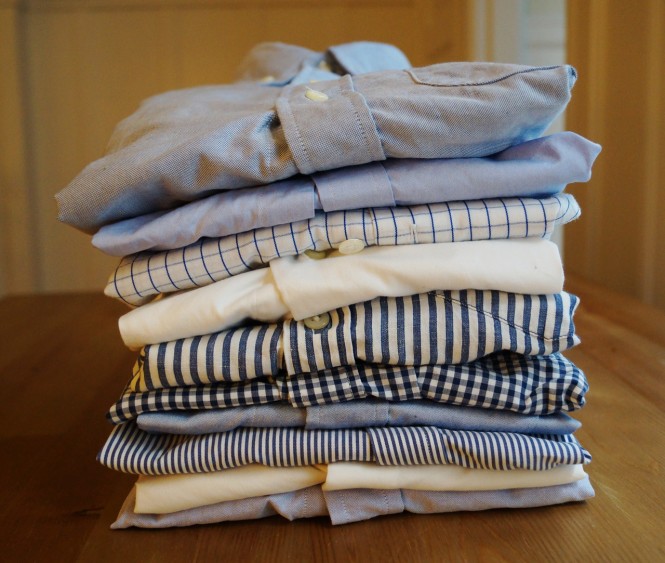Like many Americans, I work in a ‘business casual’ setting. This vague definition means different things to different people and companies, but you can be sure of one thing: you will be wearing a shirt, and that shirt will (hopefully) have buttons up the front. Since so many men eschew ties and blazers nowadays, the shirt often attracts a disproportional amount of attention in the business casual setting. Moreover, the shirt is generally not something that can be slowly accumulated over time, like blazers and shoes; when you get your first job, you’ll need a wardrobe full of them, and fast. For these reasons it seems that the dress shirt is a point of stress for many young professionals. I’ve put together a primer which will hopefully help some young men out; this may be old news to many, but it is a topic I am often asked about by friends and coworkers, and this seems like a good place for it.
1. Fit is Paramount.
I won’t go in to too much detail here since this is covered extensively elsewhere. Just make sure your collar is snug, your unbuttoned sleeves reach your first thumb joint, the yoke sits on your shoulders, and the overall silhouette follows your own without pulling during movement or sitting. Know your measurements. Take some time to find a maker that fits your body. Unlike shoes and blazers, high quality construction and materials are not as imperative; find a good fit, stay away from synthetics and factor in the cost of alterations if need be. Brooks Brothers shirts are a classic and often on sale. Many seem to have good luck with Charles Tyrwhitt, Land’s End, and TM Lewin, although I personally do not have experience with these makers. Consider going the made-to-measure route if you have a hard-to-fit body type or are obsessive about details; I highly recommend both Ratio and Proper Cloth (refer to my previous posts for more information).
2. Know your collar styles, and ignore most of them.
Most men don’t think about collar styles when dressing or shopping, but they play a large role in the presentation of your face (which is hopefully what people are focusing on). There are lots of styles out there, but you only really need to know two: the button down point collar and the spread (or semi-spread). They both have their place in the American coporate setting; the button-down works beautifully with more casual fabrics and the spread is a great backdrop for ties and jackets. Avoid shirts with the following collar terms: club, point (non-button down), cutaway, wing, and anything with the word “mini.” These collars are not bad, per se, but they will not lend themselves to building an accessible and versatile introductory wardrobe. Shoot for 2.75-3.5” point lengths, with 4-5.5” spread for the spread collars and around 3” for the button downs (these number may not always be available but they provide a good point of reference). Find what flatters you the most and stick with it. Make sure that the spread collar is wide enough and spread-y enough to tuck neatly under your jacket (in other words, avoid this).
3a. Follow the one-color rule.
Getting crazy with colors can be cool, but is by no means a necessity for dressing well. I personally follow the one-color rule: all my dress shirts are either comprised of one solid color or a pattern with one color (besides white). I’m always amazed at how many men wear shirts with furious, colorful checks and stripes to the office. Tone it down. Following this rule is not limiting; beyond solids there are various stripes, graph checks and ginghams, to name just a few.
3b. Avoid dark and oversaturated colors.
Nothing says “I got all my shirts at Express” like wearing cyan, tangerine, emerald or heliotrope (look it up) shirts. Avoid black shirts unless you’re Johnny Cash.
4. Hide your underwear.
Undershirts are a personal choice, but just remember that showing them is only a few steps above showing your briefs. If you have always worn one (like many in my generation), try going without. You may find that it really wasn’t doing anything for you in the first place. If you do want to wear one, spring for a V-neck if you want to go tie-less and consider gray instead of white to avoid them showing through.
5. Make a list and stock up.
There will be many variants in what your shirt wardrobe could entail because ‘business casual’ is such a vague term. Some may focus more on rugged fabrics and button-down collars, while other will spring for spread collars and ties. Assess your own needs and go from there. Here’s a list of what I see as my ideal shirt wardrobe:
Broadcloth, twill or pinpoint with spread or semi-spread collar
2x white (one barrel cuff, one french cuff)
2x pale/light blue (two different shades)
1x pale pink
1x lavender
1x blue/white candy stripe
1x graph check
2x blue/white gingham (different shades and check sizes)
Oxford cloth, button-down collar
2x blue
2x white
1x blue/white stripe
TOTAL: 15 shirts. 3 week’s worth. Endless combinations and hardly boring or repetitive. Once the basics are covered, feel free to start experimenting with more fabrics, patterns, and collar styles. As long as you have a core of well-fitting, versatile shirts, you’ll never be stumped when getting dressed in the morning.
There rest of the Business Casual Basics series can be found here.
